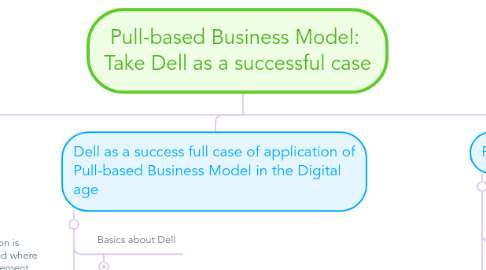
1. Pull-based Business Model
1.1. Definition of pull-based business model
1.1.1. Manufacturing system in which production is based on actual daily demand (sales), and where information flows from market to management.
1.1.1.1. Just-in-time inventory management
1.1.1.2. Build-to-order
1.1.1.3. Customer service support system
1.2. Advantages, disadvantages of pull-based business model
1.2.1. Advantages
1.2.1.1. Lower cost of inventory financing, carrying and storing goods, less planning, and lower management overhead
1.2.1.2. Reduce obsolete or expired inventories
1.2.1.3. Customer centric
1.2.2. Disadvantages
1.2.2.1. Being impractical to quickly react to demand information.
1.2.2.2. Higher shipping costs.
1.2.2.3. Ordering dilemmas
1.2.2.4. Not having enough inventory to meet demand
1.3. Pull-based business model in the digital age
1.3.1. Become more popular: moving from "push" models => "pull" model
1.3.2. Tend to be Network Value-Increasing, and Commons-based business models
1.3.3. Create “increasing returns dynamics”
1.3.4. Influence public policy with regards to education and innovation.
2. Dell as a success full case of application of Pull-based Business Model in the Digital age
2.1. Basics about Dell
2.1.1. Founded: Austin, Texas, United States (February 1, 1984)
2.1.2. Founder: Michael Dell
2.1.3. Headquarters: Round Rock, Texas, United States
2.1.4. Type of business: a computer hardware manufacturer and distributor.
2.1.5. Type of company: private
2.1.6. Industry: computer hardware, computer software, IT services, IT consulting
2.1.7. Area served: Worldwide
2.1.8. PRODUCTS
2.1.8.1. Laptops, Destops, Tablets, Monitors
2.1.8.2. Printers & Ink, Gaming, Networking, Software
2.1.8.3. Electronic&Accessories, Servers & Storage, Workstations, Thin Clients
2.1.9. OBJECTIVE
2.1.9.1. Commit to substance. Grow with clarity
2.1.9.2. Delivering results that make a positive difference
2.1.9.3. Leading with openness and optimism
2.1.9.4. Winning with integrity
2.1.9.5. Support positive growth Watch the world thrive
2.1.10. BUSINESS MODEL
2.1.10.1. "Configure to order" approach to manufacturing
2.1.10.2. Proximity to customers and suppliers
2.1.10.3. Low inventory
2.2. Supply chain of Dell: CUSTOMERS=> SALES REPRESENTATIVE => DOMS
2.2.1. DOMS
2.2.1.1. FINANCIAL DEPARTEMENT
2.2.1.1.1. To check customer’s means of payment
2.2.1.2. ENGINEERING
2.2.1.2.1. To be sure that the desired configuration is technically feasible
2.2.1.3. PLANT
2.2.1.3.1. The printout order come to workers.
2.2.1.3.2. Checked against inventory
2.2.1.3.3. Assemble/Test/Burn-in/ Download with software/ Package for shipping
2.2.1.3.4. Attach an Ethernet cable
2.2.2. Business Strategies
2.2.2.1. Direct sales
2.2.2.1.1. Accurate forecasting of demand
2.2.2.1.2. Segmentation of demand
2.2.2.1.3. Early indication of shifts in demand
2.2.2.2. Build-to-order
2.2.2.2.1. Better control of operations
2.2.2.2.2. Reduced inventory and transit points
2.2.2.2.3. Better communication during build process
2.2.2.2.4. Improved monitoring and evaluation of production and supplier quality
2.2.2.3. Direct Dell distribution
2.2.2.3.1. Accelerated outbound
2.3. How dell can achieve competitive advantages using Internet-based application of pull-based business model
2.3.1. Integrate with supplier
2.3.1.1. IT application
2.3.1.1.1. Dell Integrated Logistics, i2 Technologies Rhythm forecasting
2.3.1.2. Performance effect
2.3.1.2.1. Accelerated inbound logistics, better forecasting, reduced inventory, reduced supplier risk
2.3.1.2.2. Faster, better decisions time System and information flows, streamlined ordering system
2.3.2. Integrate with customers
2.3.2.1. IT application
2.3.2.1.1. Dell Configurator
2.3.2.1.2. DellPlus
2.3.2.1.3. Premier Pages Dell Online, Internet
2.3.2.2. Performance effect
2.3.2.2.1. Greater customer service, satisfaction and loyalty, , retention of relationship
2.3.3. Reach new geographic markets and customer segments
2.3.3.1. IT application
2.3.3.1.1. Same as above
2.3.3.2. Performance effect
2.3.3.2.1. Increased market share in transaction customers and internationally, increased revenues
2.3.4. Virtually integrate value chain and globally
2.3.4.1. IT application
2.3.4.1.1. The entire information
2.3.4.2. Performance effect
2.3.4.2.1. Greater efficiency across the across the value chain and globally
3. Recommendation for VN enterprises
3.1. Current status of application of Pull-based Business Model in VN
3.1.1. 90% Vietnamese enterprises don’t take advantage of Pull-based model applications
3.1.2. Only 0,05 - 0,08 % from sales for investing in this business model
3.2. SWOT analysis for VN enterprises in application of Pull-based Business Model in VN
3.2.1. STRENGTHS
3.2.1.1. Textile, food product and car assembling industry develop
3.2.1.2. Managerial ability is enhanced
3.2.1.3. Intention to apply new business model
3.2.2. WEAKNESSES
3.2.2.1. Sense of responsibility of employee is low
3.2.2.2. Few enterprises accept changes
3.2.2.3. Ability of management Consultants is limited
3.2.2.4. Lack of capital
3.2.3. OPPORTUNITIES
3.2.3.1. IT development thorough system
3.2.3.2. Globalization
3.2.4. THREATS
3.2.4.1. Maintenance & upgrading: Expensive, Complex, and Time-consuming
3.2.4.2. Lose controlling ability: Depend entirely on the infrastructure of application providers
3.2.4.3. More risk: Leaking information to competitors
3.3. Recommendations for VN
3.3.1. Technology
3.3.1.1. Improve technology
3.3.1.2. Use information technology
3.3.1.3. Invest in infrastructure
3.3.2. People
3.3.2.1. Advisory team- highly qualify and experience
3.3.2.2. Requires the engagement of senior management
3.3.2.3. Highly skilled labors
3.3.3. Performing
3.3.3.1. Make a detail planning
3.3.3.2. Start with a small scale
